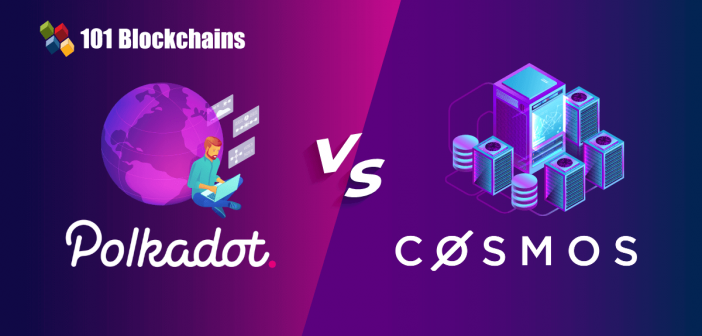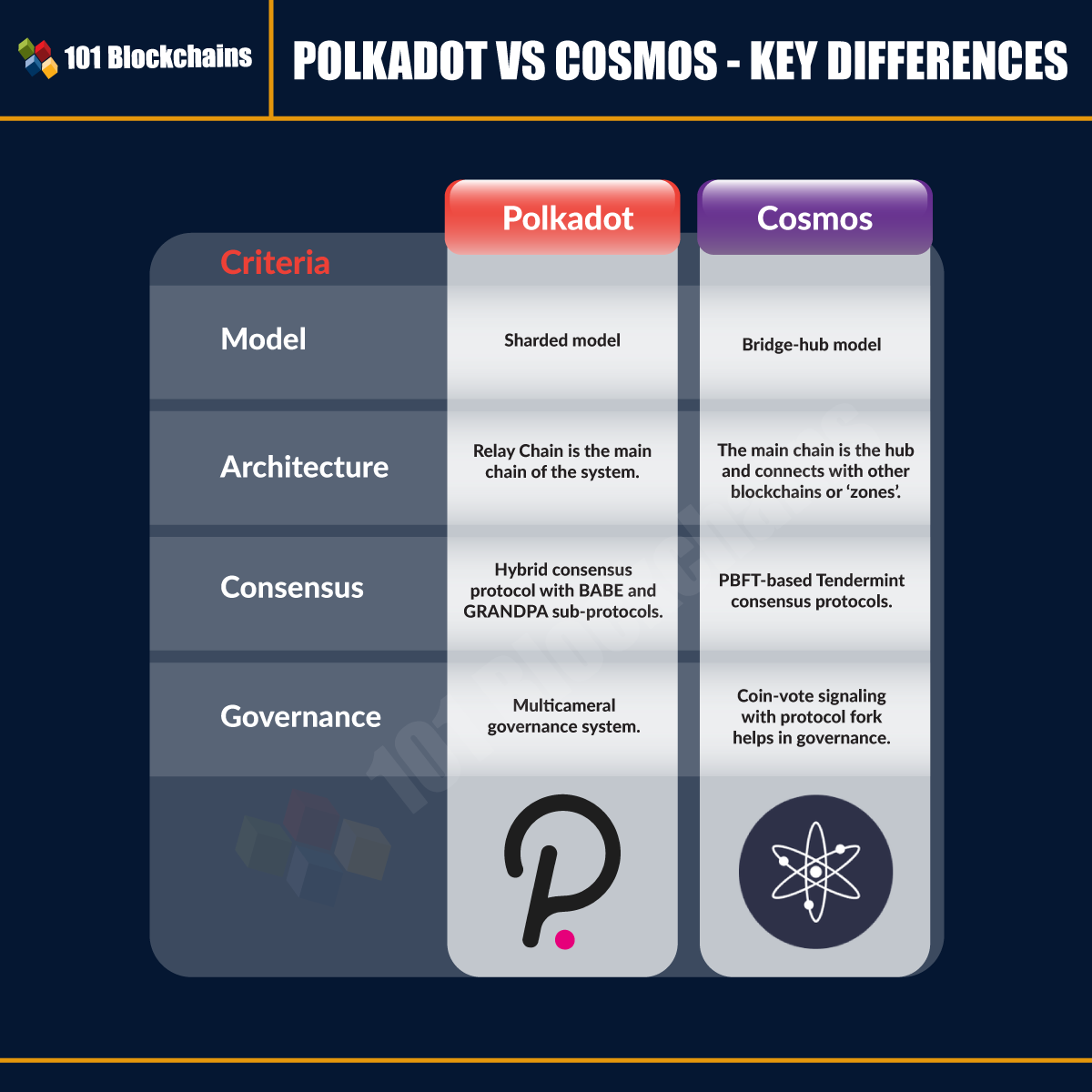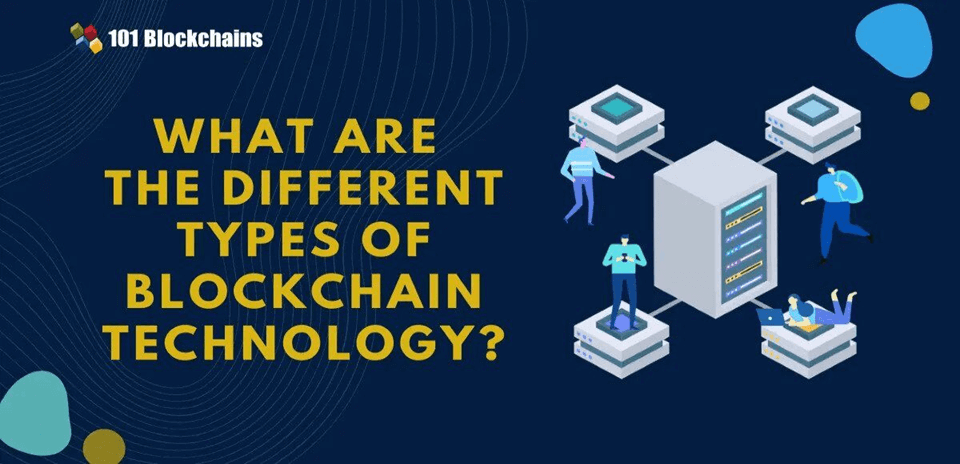Learn how blockchain truly works, master key definitions, and uncover what makes smart contracts so "smart." Dive into the fundamentals, gain valuable insights, and start your blockchain journey today!

- Reviews
Diego Geroni
- on July 28, 2021
Polkadot vs Cosmos – Key Differences
Want to learn how Polkadot is different from Cosmos? Let’s find out the differences between Polkadot and Cosmos i.e. Polkadot vs Cosmos.
In the present time, it is quite difficult to find the compatibility between different blockchains. For the transfer of cost between blockchains, tokens must be moved to a crypto exchange followed by the exchange procedure before a new token is transferred to another blockchain. The process clearly indicates how slow, expensive and risky it is, especially on the grounds of the involvement of intermediaries.
Blockchain networks are more like islands in the existing situation when they don’t have any connection irrespective of being close to each other. The discussion on Polkadot vs Cosmos has recently started to gain attention. Both of them are unique protocols for offering an interface that could help different state machines in communicating with each other. A detailed overview of the differences between Polkadot and Cosmos could help in finding out the better alternative among them.
Build your identity as a certified blockchain expert with 101 Blockchains’ Blockchain Certifications designed to provide enhanced career prospects.
Blockchain Interoperability
The discussions on Cosmos vs Polkadot reflect largely on introducing blockchain interoperability. If you are still unfamiliar with both projects, then you could go out and access many resources on learning about them. Blockchain interoperability exists in the most trivial proportions without any efficient connection between all networks. In addition, the network effect in blockchain also ensures that the service becomes more valuable when more people use it. Many of the discussions on differences between Cosmos and Polkadot do not offer nuanced coverage of details.
Enroll now in the Blockchain Scalability and Interoperability Mastery Course to learn the skills needed to develop faster, scalable, robust, and interoperable dApps.
Why Do You Need Polkadot or Cosmos?
Is it necessary to build a new interface like Polkadot or Cosmos? The two primary reasons for building an application-specific blockchain could offer the foundation on which you can develop an understanding of Polkadot vs Cosmos differences. Why shouldn’t you write the application as a smart contract on every existing platform? The first reason obviously points out the lack of customizability and flexibility in the existing smart contract platform. Writing the blockchain from scratch gives considerable flexibility and freedom in designing the core logic for addressing specific application needs.
Another reason for which you come across Cosmos and Polkadot refers to sovereignty. The development of an application on a smart contract platform forces an application under the control of rules and governance pertaining to the protocol. Subsequently, a naturally independent and sovereign chain could take away the features for seamless communication with other applications. Polkadot and Cosmos solve this problem by offering distinct functionalities.
Cosmos is a leading cryptocurrency platform with a profound focus on improving blockchain interoperability. It enables the creation of highly scalable, high-performance and customizable applications. The Proof-of-Stake (PoS)-based Polkadot platform also allows independent blockchain networks for communicating with each other.
Differences between Polkadot and Cosmos

Please include attribution to 101blockchains.com with this graphic. <a href='https://101blockchains.com/blockchain-infographics/'> <img src="https://101blockchains.com/wp-content/uploads/2021/07/POLKADOT-VS-COSMOS-KEY-DIFFERENCES.png" alt="Polkadot vs Cosmos" border='0' /> </a>
Polkadot and Cosmos are favorable protocols for offering an interface that helps various state machines in communicating with each other. The protocols follow the same assumption that interoperability of multiple blockchains would become a necessity in the future. Individual blockchains would not exist in isolation anymore. So, it is inevitable to wonder about ‘Is Polkadot or Cosmos better?’ when thinking of blockchain interoperability. Here are some of the notable factors which showcase the differences between Polkadot and Cosmos.
-
Model
The first point of difference in the Cosmos vs Polkadot comparison refers to the type of model used in them. Polkadot depends on a sharded model in which every shard in the protocol features an abstract STF or state transition function. In addition, Polkadot leverages Wasm or WebAssembly in the form of a ‘meta protocol.
The STF of a shard remains in abstract form until validators on Polkadot are capable of executing it in a Wasm environment. The shards in Polkadot are known as ‘parachains’. When a parachain attempts a state transition, it should submit a block and state proof for independent verification by Polkadot validators. All the parachains share state throughout the whole system.
On the other hand, of the Cosmos and Polkadot comparison, Cosmos features a bridge-hub model connecting Tendermint chains. The system features multiple hubs, with the primary one termed as ‘Cosmos Hub’. Each hub is connected to an assortment of external chains, known as ‘zones’. Every zone is responsible for the security of the chain with an adequately staked and decentralized validator set. Zones could send messages and tokens seamlessly to each other through the hub by leveraging the Inter-Blockchain Communication protocol.
-
Architecture
The comparison of Polkadot vs Cosmos would also bring the architecture of both tools into account. Polkadot features a Relay Chain which serves as the main chain for the system. You can find all the validators in Polkadot on the Relay Chain. The parachains include collators, who take responsibility for constructing and proposing parachain blocks to validators. The collators do not have to take on any security responsibilities, thereby negating the need for a strong incentive system.
Collators could submit a single parachain block for each Relay Chain block at an interval of 6 seconds. After a parachain submits a block, validators carry out various availability and validity checks before it is committed to the final chain. Parachain candidates must participate in auction for reserving slots for a period of up to two years. You can also choose parathreads in cases where you don’t have funding for a parachain slot.
Cosmos architecture includes the main chain, referred to as ‘hub’. The hub is responsible for connecting other blockchains, referred to as ‘zones’. Cosmos could feature multiple hubs, and all zones should maintain their respective state. So, all zones have their own validator communities. If a zone has to communicate with another zone, it could send packets through the IBC protocol.
The hub is responsible for the maintenance of a multi-token ledger of token balances. Zones are capable of monitoring the state of the hub with a light client. However, the hub does not have capabilities for tracking zone states. The zones should use a deterministic finality algorithm such as Tendermint and deploy the IBC interface for sending messages to other chains across the hub.
-
Consensus
Another important point of difference for Cosmos and Polkadot refers to the consensus mechanism they follow. Polkadot depends on a hybrid consensus protocol along with two sub-protocols such as BABE and GRANDPA. Both of the sub-protocols are collectively referred to as ‘Fast Forward’. BABE or Blind Assignment for Blockchain Extension leverages a verifiable random function or VRF for the assignment of slots to validators.
In addition, BABE also utilizes a fallback round-robin pattern for guaranteeing that every slot features its own author. GRANDPA or GHOST-based Recursive Ancestor Deriving Prefix Agreement follows a consensus approach involving votes on chains and not on individual blocks. Both of them could ensure the authoring of candidate blocks for extension of finalized chain and finalizing them in batches.
Cosmos utilizes the Tendermint consensus protocol. It is actually a round-robin protocol with the provision of instant finality. The unique detail about Cosmos is that it involves the production and finalization of one block at a time. Interestingly, Cosmos relies on a PBFT-based algorithm just like GRANDPA for consensus. Therefore, it showcases quadratic transport complexity even if it could finalize only one block at a time.
-
Governance
The aspect of governance is also crucial for finding answers to ‘Is Polkadot or Cosmos better?’ just like in this case. Polkadot features a multicameral governance system that has different avenues for passing proposals. All the proposals would pass through a public referendum, thereby allowing the majority of tokens to take control of the outcome. In the case of low-turnout referenda, Polkadot utilizes adaptive quorum biasing for the configuration of the passing threshold. Referenda could include various proposals, such as ones for fund allocation from on-chain treasuries.
On the other end of the debate, Cosmos utilizes coin-vote signaling for passing referenda. A protocol fork is responsible for the actual enforcement of governance decisions, just like many other blockchains. All the token holders could vote in the protocol fork. However, delegator refraining from a vote would imply that the validator assumes voting power. This is different from Polkadot, where the validators do not get any voting power on the basis of nominators.
Not sure how to build your career in enterprise blockchains? Enroll Now in How to Build Your Career in Enterprise Blockchains Course
-
Upgrades
The final point of comparison between Cosmos and Polkadot in this discussion ultimately brings us to upgrades. With the help of the Wasm meta-protocol, Polkadot could ensure chain upgrades and successful proposals without hard forks. Polkadot gives adequate flexibility for upgrading almost anything in the STF, off-chain workers, or transaction queue without forking the chain.
Cosmos does not have a meta-protocol and should work on deploying upgrades and proposals through normal forking mechanisms.
Start your blockchain journey Now with the Enterprise Blockchains Fundamentals
Bottom Line
Polkadot and Cosmos definitely have a lot of differences between them. However, there is no specific answer to which one is the better alternative among them. Both the tools have unique features. Polkadot has been tailored on the principle that interoperability and scalability depend largely on shared validation logic.
Cosmos, on the other hand, gives a bridge-hub model for connecting chains with independent security assurances. While the differences between Cosmos and Polkadot have many other underlying factors, it is important to understand both tools. Start exploring more about Polkadot and Cosmos to find out how blockchain interoperability can become the new norm.
*Disclaimer: The article should not be taken as, and is not intended to provide any investment advice. Claims made in this article do not constitute investment advice and should not be taken as such. 101 Blockchains shall not be responsible for any loss sustained by any person who relies on this article. Do your own research!







